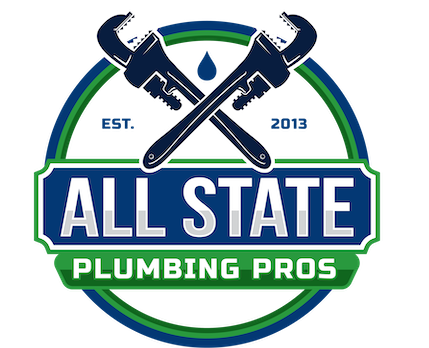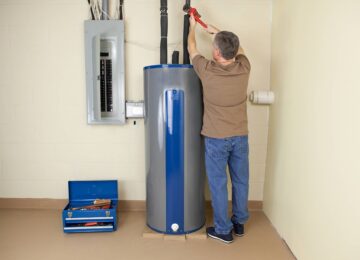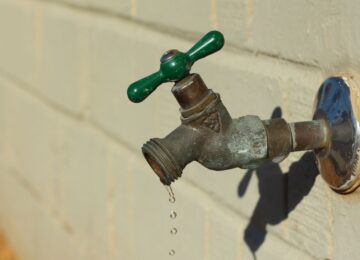If you’re facing the frustration of low water pressure from your well, you’re likely asking how to increase water pressure from a well. This guide will help you identify common issues, provide simple adjustments, and suggest advanced solutions to ensure a strong and steady water flow throughout your home. Let’s dive into the topic: How to Increase Water Pressure from a Well.
Key Takeaways
-
Low water pressure in well systems can result from high usage, clogged pipes, and faulty pumps, and identifying these causes is essential for effective solutions.
-
Simple adjustments, like modifying the pressure switch and checking the pressure tank, can significantly enhance water pressure in your home.
-
For persistent low water pressure, consider advanced solutions like constant pressure systems and booster pumps, and seek professional help for mechanical issues.
Common Causes of Low Water Pressure in Well Systems
Identifying why low water pressure occurs in well systems is crucial for finding a solution. High usage times, clogged pipes and fixtures, and faulty well pumps or pressure tanks are among the primary culprits. Each of these factors can significantly impact the efficiency of your well system, leading to frustratingly low water pressure.
Examining these causes in detail helps understand their impact on your water system and how to address them. Pinpointing the root cause enables you to implement effective solutions for consistent water flow.
High Usage Times
Have you ever noticed that your water pressure seems to drop significantly during certain times of the day? Water pressure often drops during high usage times, especially in the mornings and evenings. When multiple plumbing fixtures are used simultaneously, the demand for water spikes, resulting in decreased water pressure.
During these peak demand times, implementing a constant pressure system can help maintain uniform water pressure throughout your home. Adjusting the pump speed to match household demands, a pump system maintains a steady flow rate even during peak usage.
Clogged Pipes and Fixtures
Over time, sediment and mineral deposits from hard water can accumulate in your pipes, restricting water flow and reducing pressure. This buildup can occur in various parts of your plumbing system, including aerators and showerheads, leading to decreased water pressure at the tap.
Regular cleaning of aerators and showerheads is essential to prevent mineral buildup that obstructs water flow. Maintaining these fixtures ensures a smooth and powerful water flow, akin to city water pressure.
Regular maintenance prevents clogged pipes and fixtures from sabotaging your water system.
Faulty Well Pump or Pressure Tank
A malfunctioning well pump or pressure tank can be a major source of low water pressure. If the pressure tank fails to maintain the required air pressure, it can disrupt the normal water flow, leading to inconsistent pressure. Similarly, a faulty well pump may struggle to push water efficiently, resulting in lower pressure.
Persistent water pressure issues warrant consulting a professional to inspect the well pump and pressure tank. Promptly addressing these mechanical issues can prevent further complications and ensure optimal well system efficiency.
Simple Adjustments to Increase Well Water Pressure
Small modifications to your well system can lead to significant improvements in water pressure. Simple adjustments can enhance the efficiency of your well pump and pressure tank, resulting in more consistent and powerful water flow.
Detailed adjustments include modifying the pressure switch, checking and adjusting the pressure tank, and cleaning aerators and showerheads. These steps can help you achieve the desired pressure and enjoy a better water experience.
Adjusting the Pressure Switch
The pressure switch controls the operation of your well pump and can be fine-tuned to optimize water pressure. Start adjusting the pressure switch by turning off the well pump circuit. Then, use a wrench to modify the settings based on the water pressure reading. The switch typically has two screws—one for cut-in pressure and the other for cut-out pressure.
Properly calibrated pressure set point settings can significantly improve water pressure. Carefully adjusting these set points ensures your well pump operates at optimal pressure levels, providing steady and powerful water flow.
Checking and Adjusting the Pressure Tank
Regularly check the air pressure in your pressure tank and pressure regulator to maintain optimal water delivery. Use a tire pressure gauge to accurately measure the air pressure within the tank. The air pressure should be set to 2 psi below the cut-in pressure for the best performance.
If the pressure in the tank is too low, you can use an air compressor to add more compressed air until the desired pressure is reached. Correct air pressure in the tank ensures consistent water flow and prevents pressure drops.
Cleaning Aerators and Showerheads
Faucets and showerheads can accumulate mineral deposits and sediment over time, leading to reduced water pressure. Regularly cleaning these fixtures maintains optimal water flow. Remove the aerators and showerheads, soak them in a vinegar solution to dissolve mineral buildup, and scrub them clean.
Routine cleaning and maintenance prevent future buildup and ensure steady water flow. By keeping your aerators and showerheads clean, you can enjoy higher water pressure and a more satisfying shower experience.
Advanced Solutions for Persistent Low Water Pressure
Advanced solutions may be needed for persistent low water pressure issues. These solutions often involve upgrading your well system with technologies that automatically adjust pump speed to meet varying water demands.
Explore three advanced options: installing a constant pressure system, adding a water pressure booster pump, and upgrading to a submersible pump. These solutions can provide long-term improvements and ensure a reliable water supply.
Installing a Constant Pressure System
Constant pressure systems are designed to improve well water pressure by matching pump speed with household demands. These systems control water pressure by increasing or decreasing the speed of the pump, ensuring a steady flow even during peak usage times.
Installing a constant pressure system can be particularly beneficial for multi-story homes, where maintaining uniform water pressure can be challenging. These systems maintain a consistent flow rate, preventing pressure drops and ensuring a reliable water supply.
Adding a Water Pressure Booster Pump
A water pressure booster pump can significantly increase water pressure throughout your home, improving water flow for all household activities. Install a booster pump by connecting it after the existing pressure tank and following the manufacturer’s instructions.
A booster pump increases water pressure, improving performance in showers, faucets, and appliances requiring strong water flow. Regular maintenance checks and proper pump adjustments ensure optimal performance.
Upgrading to a Submersible Pump
Submersible pumps are designed to be submerged in the water source, often resulting in better efficiency and higher water output compared to traditional pumps. These pumps are particularly useful for deep wells and can significantly improve water pressure.
Upgrading to a submersible pump offers better efficiency and a more reliable water supply. These pumps provide higher water pressure and are ideal for households with deeper wells.
When to Call a Professional
Sometimes, professional help is necessary to address low water pressure issues. Mechanical problems such as pump failure or pressure tank issues can significantly impact water pressure and require expert attention. Recognizing mechanical failure signs and scheduling routine maintenance and inspections are vital for a functional well system.
Explore these aspects in detail.
Signs of Mechanical Failures
Unusual sounds such as clicking, grinding, or squealing from the well system typically indicate mechanical issues that need inspection. Frequent cycling of the well pump may also signify a malfunctioning pressure switch or pressure tank.
Addressing these signs early can prevent further damage and ensure adequate water pressure. Seek professional help if you notice any of these symptoms to diagnose and fix the problem.
Routine Maintenance and Inspection
Regular inspections by professionals can help identify potential problems early, preserving well tank functionality. Catching issues like pressure tank problems early prevents major disruptions to your water supply.
Routine maintenance and inspection ensure your well system operates efficiently and reliably. Scheduling regular check-ups with a professional can save you time and money in the long run.
All State Plumbing Pros Offers Expert Well Pump Repair Services
All State Plumbing Pros provides comprehensive well pump services, including diagnostics and repairs for both residential and commercial properties. Their team of licensed and insured professionals ensures reliable service and accurate diagnosis of well pump issues.
Whether you need emergency well pump service or routine maintenance, All State Plumbing Pros is equipped to handle all your well system needs. Certified plumbers reduce the risk of future issues and ensure the job is done properly.
Summary: How to Increase Water Pressure from a Well
Maintaining optimal water pressure from a well system involves understanding common causes of low pressure, making simple adjustments, and considering advanced solutions when necessary. Regular maintenance and professional inspections are crucial for keeping your well system in top shape.
By following the expert tips and tricks outlined in this guide, you can enjoy a reliable water supply and a more comfortable home. Don’t let low water pressure disrupt your daily life—take action today and experience the benefits of a well-maintained water system.
Frequently Asked Questions: How to Increase Water Pressure from a Well
What are the common causes of low water pressure in well systems?
Low water pressure in well systems is commonly caused by high usage during peak times, clogged pipes or fixtures, and malfunctioning well pumps or pressure tanks. Addressing these issues can help restore proper water pressure.
How can I adjust the pressure switch to improve water pressure?
To improve water pressure, turn off the well pump circuit and adjust the cut-in and cut-out pressure settings using the screws on the pressure switch. This simple adjustment can enhance your system’s efficiency.
Why is it important to clean aerators and showerheads regularly?
Regularly cleaning aerators and showerheads is essential as it prevents mineral deposits and sediment buildup, ensuring optimal water pressure and flow. This maintenance can significantly enhance the efficiency and longevity of your fixtures.
What are the benefits of installing a constant pressure system?
Installing a constant pressure system ensures consistent water pressure across your home, adapting the pump speed to meet varying demands, which greatly enhances comfort and convenience. This reliability minimizes fluctuations during peak usage, ensuring a steady supply of water.
When should I call a professional for well pump issues?
You should call a professional for well pump issues if you experience unusual sounds, frequent cycling, or significant drops in water pressure, as these can indicate mechanical failure. Seeking expert help ensures proper diagnosis and resolution of the problem.

![How to Increase Water Pressure from a Well: Expert Tips and Tricks If you’re facing the frustration of low water pressure from your well, you’re likely asking how to increase water pressure from a well. This guide will help you identify common issues, provide simple adjustments, and suggest advanced solutions to ensure a strong and steady water flow throughout your home. Let’s dive into the topic: How […]](https://allstateplumbingct.com/wp-content/uploads/2025/03/How-to-Increase-Water-Pressure-from-a-Well-750x420.jpg)



Leave a Reply